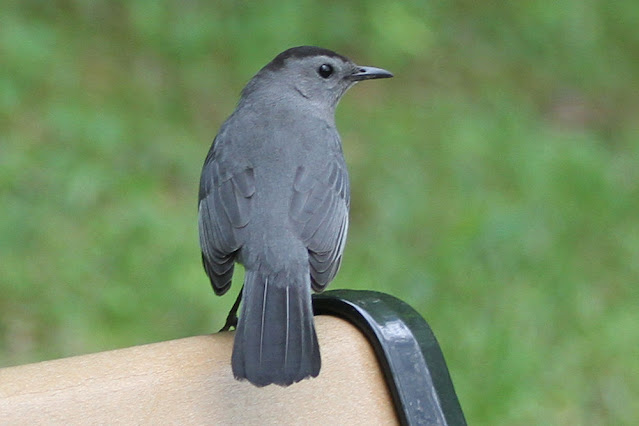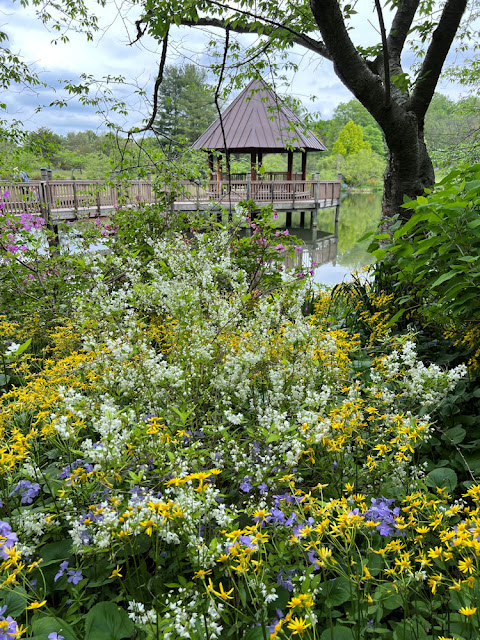The Canada Goose is always present at the garden, but not in great numbers. I didn’t see any nests but may have missed them. I don’t actually go looking for them.
“The gander is a fierce defender of his mate and offspring, and will charge any suspected enemy, even one as large as an elk. Mated pairs can be together as long as 20 years.” This, as I once found out, applies when nests are being built. I wasn’t charged but definitely warned away when coming across a nest unexpectedly. You may have your own stories.
“The nest is a large mound of vegetation such as grass and cattail stems lined with down. It is usually located within sight of water. 4 to 7 white eggs make up a typical clutch and incubation is done solely by the female. The gander (male) zealously guards the nest and will attack any intruders. Incubation takes 25 to 30 days and the goslings are led to water within a day after hatching. The goslings stay with the parents until the following spring.”
If you have young ones in the family, there is a website for kids at this link. It is where I found the above information.
We were delighted to find a Catbird posing long enough for a photo. These are also regular visitors at our home. A site where I found the following information, also with young people in mind, can be found here. “The North American gray catbird lays anywhere between one to five eggs.” and “Catbirds are a group of 14 different birds that are found basically all over the world. These birds belong to four different genera from three different families. The Ptilonorhynchidae family include Australasian catbirds of the genera Ailuroedus and Scenopooetes. Black and gray catbirds are from the Mimidae family, and the Abyssinian catbird is from the Timaliidae family. Catbirds have been given this name because of their cat-like and wailing calls. Australasian catbirds are endemic to Australia and New Guinea, black catbirds to the Yucatán Peninsula, Abyssinian catbirds to Ethiopia, and gray catbirds are North American birds.”
We are walking around Lake Caroline and will often visit the gazebo if it is quiet. Today we decided to carry on to Lake Lena, but first took a few more photos along the way.
I can see phlox here, a white flower I am not sure of. I should have taken a closer look.
The yellow flower I do know is Golden ragwort. Its botanical name is Packera aurea. Another name for it is Golden groundset. It blooms in spring and summer, and is a perennial.
One of my favorite areas is where the peonies bloom. There were a few reds and pinks, but it was still relatively quite as far as blooms were concerned. Their botanical name is Paeonia lactiflora. Another name for it is the Common garden peony.
We arrive at Lena Lake and there was more Azalea blooming, but I will stop here for now. That part of our walk will be in another post when I get one together.











Beautiful flowers today. Yes, the geese will crook and lower their necks and go after you! Interesting about the Ragwort; I will keep an eye out for it.
ReplyDeleteHi Ginny, thank you :) I remember sitting on a chair and the gander came over, stuck its tongue out at me, and when I didn't move, proceeded to peck at my shoelaces. I got the message :))) Ragworts do make a nice display.
DeleteThank you for yet again taking us with you to this magical place.
ReplyDeleteYou are very welcome and thank you Sue, so glad you enjoyed it :)
DeleteThe catbird is beautiful! We have seen some Canada geese with the family last few weeks on our walk along the river too.
ReplyDeleteThank you Angie :) A river walk sounds wonderful.
DeleteSimply stunning! And it all looks so peaceful.
ReplyDeleteGlad you enjoyed Anni and yes, so peaceful :)
DeleteGostei destas belas flores.
ReplyDeleteUm abraço e bom fim-de-semana.
Andarilhar
Dedais de Francisco e Idalisa
O prazer dos livros
Fico feliz que tenha gostado das flores. Muito obrigado! Um abraço e um ótimo final de semana para você :)
DeleteHello Denise, Love all the beautiful blooms. Great captures of the Catbird and the Geese. Have a safe and happy Memorial Day weekend.
ReplyDeleteThank you so much Eileen, and I wish you the same :)
DeleteSuch a lovely spring post!
ReplyDelete(ツ) from Cottage Country Ontario , ON, Canada!
Thank you Jenn, happy you think so :)
Deletegorgeous flowers. one reason you rarely see bird photos on my blog is the fact I have been attacked by gander, gobbler, 2 roosters and a close call with a peacock male during mating season.. the first four were as a child the peacock was in Jungle Gardens and I was OLD
ReplyDeleteOh dear Sandra, that sounds decidedly unpleasant and quite a list! I remember being chased by a goose once when I was six, but fortunately I have never had a major confrontation, except for one goose and even he was just warning me away without really attacking me.
DeleteI'm VERY careful when I'm walking around the geese. I love them and seeing their babies and you don't want to mess with them!
ReplyDeleteVery wise Jeanie :) I feel the same way as you.
DeleteGreat place to visit. You show that there is so much more than just what we see. I mean great photos but you've done your research and provide much information.
ReplyDeleteThank you Red, I appreciate those kind comments. I enjoy learning as I go along. Some of it sticks :)
DeleteNice! I like those geese.
ReplyDeleteThank you Gigi, happy you liked the geese.
DeleteHave a nice weekend.
ReplyDeleteThank you Anne, you too :)
DeleteThe flowers are beautiful growing in a naturalistic way. I like to see waterbirds on my walks by a river or reservoir. I'm wary and don't go too near big waterbirds. Our UK protected mute swan looks serene swimming in the water, but can be intimidating when walking on land.
ReplyDeleteHello linda :) they certainly are and walking by a river or a reservoir sounds wonderful! Swans are majestic birds but not to be taken for granted. I have heard their wings can break an arm when protecting their young.
DeleteGeese can be quite fearless.
ReplyDeleteThey certainly can and their feistiness always makes me smile.
DeleteBeautiful scenes, Denise. Such a nice relaxing place to stroll in.
ReplyDeleteIt always is Ellen, thank you :)
DeleteAnother great post. We have lots of geese here, year round. They don't seem to migrate like they are supposed to do. I've never been charged either but I've gotten the look from the gander and just back off. The silly birds will take their young across major streets and people are pretty patient with them.
ReplyDeleteSometimes a homeless person or two will help stop traffic to get the family safelly across.
That's sweet, about the homeless person seeing them safely across the street. There is one traffic light we have to stop at and occasionally we will see parent geese seeing their goslings across, one in front, one behind. It is an endearing sight. It is always smart to know when to back away :)
DeleteI mostly saw geese flying south in the fall in Michigan and then north in the spring - never have seen a nest but I'd love to
ReplyDeleteHi Carol, the sight of geese flying overhead, and honking as they go, is awesome. I hope you see your nest one day. Thank you for your help with your blogger feed, very grateful :)
DeleteHow wonderful to see such beauty..thanks for sharing.
ReplyDeleteThank you Margaret and you are very welcome :)
DeleteGreat photos of the Canadian Geese. One of my favorites for sure. Their honk is LOUD, and they seem to be protective with their family. Their long necks are funny looking. You saw many interesting things at Lake Caroline. It looks like a peaceful place to visit.
ReplyDelete~Sheri
Thank you Sheri, I am very happy you enjoyed :) The geese are fun to watch.
Delete